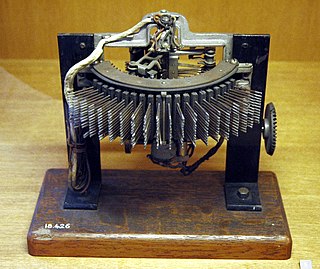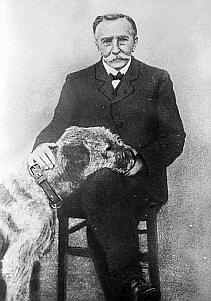
Bell Labs is an American industrial research and scientific development company. Researchers from there are credited with the development of radio astronomy, the transistor, the laser, the photovoltaic cell, the charge-coupled device (CCD), information theory, the Unix operating system, and the programming languages B, C, C++, S, SNOBOL, AWK, AMPL, and others. Ten Nobel Prizes and five Turing Awards have been awarded for work completed at Bell Laboratories.

GTE Corporation, formerly General Telephone & Electronics Corporation (1955–1982), was the largest independent telephone company in the United States during the days of the Bell System. The company operated from 1926, with roots tracing further back than that, until 2000, when it was acquired by Bell Atlantic; the combined company took the name Verizon.

A rotary dial is a component of a telephone or a telephone switchboard that implements a signaling technology in telecommunications known as pulse dialing. It is used when initiating a telephone call to transmit the destination telephone number to a telephone exchange.

The 5ESS Switching System is a Class 5 telephone electronic switching system developed by Western Electric for the American Telephone and Telegraph Company (AT&T) and the Bell System in the United States. It came into service in 1982 and the last unit was produced in 2003.

Almon Brown Strowger was an American inventor who gave his name to the Strowger switch, an electromechanical telephone exchange technology that his invention and patent inspired.

The Strowger switch is the first commercially successful electromechanical stepping switch telephone exchange system. It was developed by the Strowger Automatic Telephone Exchange Company founded in 1891 by Almon Brown Strowger. Because of its operational characteristics, it is also known as a step-by-step (SXS) switch.
The Western Electric Company was an American electrical engineering and manufacturing company officially founded in 1869. A subsidiary of the American Telephone and Telegraph Company for most of its lifespan, it served as the primary equipment manufacturer, supplier, and purchasing agent for the Bell System from 1881 until 1984, when the system was dismantled. The company was responsible for many technological innovations, as well as developments in industrial management.

This timeline of the telephone covers landline, radio, and cellular telephony technologies and provides many important dates in the history of the telephone.
A Class-5 telephone switch is a telephone exchange in the public switched telephone network (PSTN) that directly serves subscribers and manages subscriber calling features. Class-5 services include basic dial-tone, calling features, and additional digital and data services to subscribers connected to a local loop.
Verizon New York, Inc., formerly The New York Telephone Company (NYTel), was organized in 1896, taking over the New York City operations of the American Bell Telephone Company.

Standard Telephones and Cables Ltd was a British manufacturer of telephone, telegraph, radio, telecommunications, and related equipment. During its history, STC invented and developed several groundbreaking new technologies including pulse-code modulation (PCM) and optical fibres.
AT&T Technologies, Inc., was created by AT&T in 1983 in preparation for the breakup of the Bell System, which became effective as of January 1, 1984. It assumed the corporate charter of Western Electric Co., Inc.

Alcatel–Lucent S.A. was a multinational telecommunications equipment company, headquartered in Boulogne-Billancourt, France. It was formed in 2006 by the merger of France-based Alcatel and U.S.-based Lucent, the latter being a successor of AT&T's Western Electric and a holding company of Bell Labs.
Telecom Valley was an area located in Sonoma County, California specifically the Redwood Business Park of Petaluma, California.

An independent telephone company was a telephone company providing local service in the United States or Canada that was not part of the Bell System organized by American Telephone and Telegraph. Independent telephone companies usually operated in many rural or sparsely populated areas.

The rotary machine switching system, or most commonly known as the rotary system, was a type of automatic telephone exchange manufactured and used primarily in Europe from the 1910s. The system was developed and tested by AT&T's American engineering division, Western Electric, in the United States, at the same time when Western Electric was also developing the Panel switch. When AT&T selected the Panel System for large American exchanges, development and sales of the No. 7-A Machine Switching System, its formal commercial name, were transferred to Western Electric's international division in Belgium. In Europe and other continents the system was met with considerable commercial success.

The Bell System was a system of telecommunication companies, led by the Bell Telephone Company and later by the American Telephone and Telegraph Company (AT&T), that dominated the telephone services industry in North America for over 100 years from its creation in 1877 until its antitrust breakup in 1983. The system of companies was often colloquially called Ma Bell, as it held a vertical monopoly over telecommunication products and services in most areas of the United States and Canada. At the time of the breakup of the Bell System in the early 1980s, it had assets of $150 billion and employed over one million people.

A telephone exchange, also known as a telephone switch or central office, is a crucial component in the public switched telephone network (PSTN) or large enterprise telecommunications systems. It facilitates the interconnection of telephone subscriber lines or digital system virtual circuits, enabling telephone calls between subscribers.
The Automatic Telephone and Electric Company was a British telephone exchange manufacturer established in 1911. After several name changes and acquisitions, the company was merged into Plessey in 1961.












